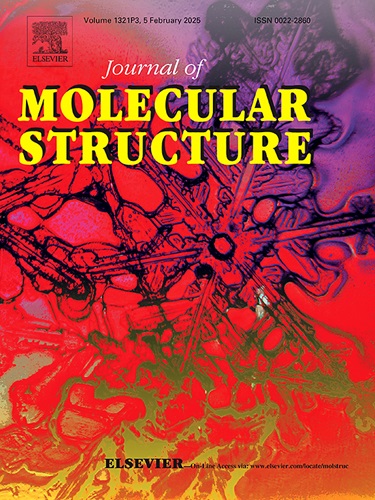Synthesis, characterization, analytical and biological applications of a novel spectrophotometrically investigated V(V)- iodochlorhydroxyquin complex
IF 4.7
2区 化学
Q2 CHEMISTRY, PHYSICAL
引用次数: 0
Abstract
A concise and innovative spectrophotometric method was developed for the trace-level determination of vanadium using iodochlorhydroxyquin (ICQ), an 8-hydroxyquinoline derivative. This approach relies on chelation, forming a green V(V)-ICQ complex under acidic conditions. The complex is formed rapidly and can be extracted into the non-aqueous organic solvent chloroform, with maximum absorbance observed between 390 and 413 nm. The metal-to-ligand [M:L] stoichiometric ratio of the complex in the chloroform phase was established as 1:2 using Job’s continuous variation method and the mole ratio method. Linearity was confirmed within the vanadium(V) concentration range of 0.0–7.0 µg mL-1. Key analytical parameters, including a molar absorption coefficient of 7.38 × 103 L mol-1cm-1, standard deviation (± 0.0005), Sandell’s sensitivity (0.0069 µg·cm⁻²),% RSD (0.2 %), limit of detection (0.21 µg mL-1), and correlation coefficient (0.999), highlighted the method’s precision, versatility, sensitivity, and cost-effectiveness. For further insights, the V(V)-ICQ complex was synthesized in a predetermined 1:2 [M:L] ratio and structurally characterized using NMR, FTIR and HR mass spectrometry. The synthesized complex was tested on various synthetic samples, including compositions analogous to standard vanadium alloys, and evaluated for its anti-bacterial, anti-cancer and DNA replication activities. The results demonstrated excellent performance, suggesting its potential for industrial and medicinal applications.
一种新型紫外分光光度法研究的V(V)-碘氯羟基醌配合物的合成、表征、分析及生物学应用
采用8-羟基喹啉衍生物碘氯羟基醌(ICQ),建立了一种简洁、新颖的测定痕量钒的分光光度法。这种方法依靠螯合作用,在酸性条件下形成绿色的V(V)-ICQ复合物。该配合物形成迅速,可被萃取到非水有机溶剂氯仿中,最大吸光度在390 ~ 413 nm之间。采用Job连续变分法和摩尔比法确定配合物在氯仿相中金属与配体的化学计量比为1:2。钒(V)浓度在0.0 ~ 7.0µg mL-1范围内呈线性关系。主要分析参数包括:摩尔吸收系数7.38 × 103 L mol- ccm -1、标准偏差(±0.0005)、桑德尔灵敏度(0.0069µg·cm - 2)、% RSD(0.2%)、检出限(0.21µg mL-1)和相关系数(0.999),突出了该方法的精密度、通用性、灵敏度和成本效益。为了进一步深入研究,我们以预定的1:2 [M:L]比例合成了V(V)-ICQ配合物,并使用NMR、FTIR和HR质谱对其进行了结构表征。合成的配合物在各种合成样品上进行了测试,包括类似于标准钒合金的成分,并评估了其抗菌、抗癌和DNA复制活性。结果表明,该材料具有良好的性能,具有工业和医学应用潜力。
本文章由计算机程序翻译,如有差异,请以英文原文为准。
求助全文
约1分钟内获得全文
求助全文
来源期刊

Journal of Molecular Structure
化学-物理化学
CiteScore
7.10
自引率
15.80%
发文量
2384
审稿时长
45 days
期刊介绍:
The Journal of Molecular Structure is dedicated to the publication of full-length articles and review papers, providing important new structural information on all types of chemical species including:
• Stable and unstable molecules in all types of environments (vapour, molecular beam, liquid, solution, liquid crystal, solid state, matrix-isolated, surface-absorbed etc.)
• Chemical intermediates
• Molecules in excited states
• Biological molecules
• Polymers.
The methods used may include any combination of spectroscopic and non-spectroscopic techniques, for example:
• Infrared spectroscopy (mid, far, near)
• Raman spectroscopy and non-linear Raman methods (CARS, etc.)
• Electronic absorption spectroscopy
• Optical rotatory dispersion and circular dichroism
• Fluorescence and phosphorescence techniques
• Electron spectroscopies (PES, XPS), EXAFS, etc.
• Microwave spectroscopy
• Electron diffraction
• NMR and ESR spectroscopies
• Mössbauer spectroscopy
• X-ray crystallography
• Charge Density Analyses
• Computational Studies (supplementing experimental methods)
We encourage publications combining theoretical and experimental approaches. The structural insights gained by the studies should be correlated with the properties, activity and/ or reactivity of the molecule under investigation and the relevance of this molecule and its implications should be discussed.
 求助内容:
求助内容: 应助结果提醒方式:
应助结果提醒方式:


